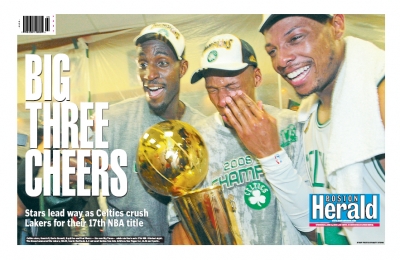R.I.P.
North American metro dailies that have closed since this site was created in March, 2007
Wikipedia list of defunct U.S. newspapersW.I.P.
Works In Progress: Major metro dailies that have cut frequency or adopted hybrid online/print or online-only models.Catskill Daily Mail & Hudson Register-Star
Flint Journal; Bay City Times; Saginaw News
Harrisburg Patriot-News, Syracuse Post-Standard
New Orleans Times-Picayune; Birmingham News; Huntsville Times; Mobile Press-Register
-
Journalism Sites
Perhaps hoping that no one would notice bad news if it was released on a post-Memorial Day Friday afternoon, the Newspaper Association of America quietly reported that advertising sales by US newspapers fell a record 14% in the first quarter, with real estate and recruitment ads both shrinking 35%. The results are worse than even the most pessimistic skeptics predicted and may indicate that the industry has entered an irreversible death spiral.
BusinessWeek’s Jon Fine thinks the unthinkable: one or more major metro dailies will go under within the next 18 months. It isn’t such an outrageous idea. Rising newsprint and gasoline prices are layering more burdens on top of an already troubled industry that distributes its product by truck. Some publishers have seriously floated the idea of cutting out unprofitable Monday and Tuesday editions. MediaNews CEO Dean Singleton recently estimated that 19 of the top 50 US newspapers are losing money.
If more than a third of top US titles are losing money, then the spiral has probably begun. The only way to stop it is to cut deeply and painfully, with staff cuts of 40% or more and a primary focus on online delivery.
However, that’s not likely to happen. Businesses in trouble rarely have the stomach or the investor support for substantive change. Instead, they do what all of them are doing today: cut 5% to 10% here and there until they slowly bleed to death. I outlined this scenario in my 2006 essay on the collapse of newspapers and the reinvention of journalism:
Newspapers will be forced to lay off staff in order to maintain margins. Cuts in services will lead to cuts in editorial coverage, making papers less relevant to subscribers. As circulation declines, advertising rates will have to come down to remain competitive. This will put more pressure on margins, leading to more layoffs, more cost cuts, more circulation declines and more pressure on margins. Once this spiral begins, it will accelerate with breathtaking speed.
If you look at Alan Mutter’s analysis of the McClatchy layoffs, you can see how this scenario could play out. In Mutter’s view, the cuts won’t even cover a quarter of McClatchy’s revenue shortfall. That means more cuts will have to be made, further hobbling the capacity for its papers to produce a quality product. Reader attrition continues. And so on and so on.
Each of these trends is playing out right now, only a lot faster than I predicted. The longer publishers fiddle with hiring freezes and redesigns, the longer they put off the tough decisions that could still save some of them. Unfortunately, for the majority of US newspapers, it’s already too late.
Big Changes in Store at the LA Times?
Speculation has swirled for a few weeks that Los Angeles Times Publisher David Hiller won’t last the summer, but now the rumors are getting louder. After losing out in an attempt to undermine his own editor last week, Hiller now looks vulnerable, and there are reports that he could be gone as early as July. The changes could also be accompanied by deep cuts in the LA Times editorial staff. We’ve heard up to 19% of the newsroom could be let go, though no decision has been made yet. The LA Times was one of the papers recently singled out by Tribune Co. CEO Sam Zell and COO Randy Michaels for poor journalist productivity.
And Finally…
CNN reports on a Yahoo employee who Twittered his layoff in February and gained an eager following. Ryan Kuder recently took a job from the hundreds of leads contributed by his Twitter followers . His story was covered on prominent blogs and has now jumped to mainstream media. All of which shows how one person can make a difference these days.
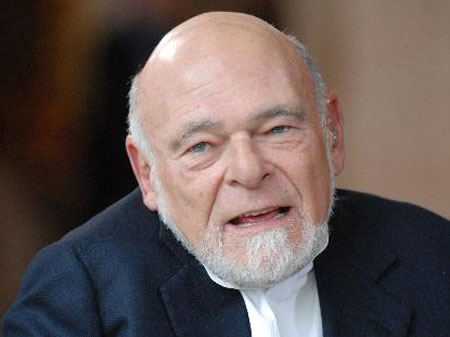 You have to wonder if Chicago Tribune owner Sam Zell wishes he had stayed in the predictable world of real estate, where market collapses are at least cyclical. As a novice publishing CEO presiding over a market shift of historic proportions, he looks increasingly helpless even as he becomes more belligerent. Among the recent stories:
You have to wonder if Chicago Tribune owner Sam Zell wishes he had stayed in the predictable world of real estate, where market collapses are at least cyclical. As a novice publishing CEO presiding over a market shift of historic proportions, he looks increasingly helpless even as he becomes more belligerent. Among the recent stories:
Tribune Publisher Quits
The Chicago Tribune is losing its publisher. Scott Smith exits after 30 years at the paper, saying he’s done as much as he can do within the confines of a set of goals that he no longer owns. One suspects that the cost cuts recently outlined by his new bosses were probably a factor, although Smith tells the Tribune that isn’t so. Smith is diplomatic in his exit interview while his Tribune Co. COO damns with faint praise, describing Smith as having been “helpful as we implement our plans for the future.†(via Romenesko)
Public Rebuke for LA Times Publisher
LA Observed posts a memo by LA Times editor Russ Stanton outlining plans to shut down the monthly Los Angeles Times Magazine. What’s interesting is that the memo comes from Stanton and non Stanton’s boss, publisher David Hiller. The two were in the spotlight last week when The New York Times reported that Hiller planned to pull the rug out from under his own editor by re-launching the magazine as a kind of advertorial without telling the readers or even the editors.
Given the publicity this stunt must have generated within the organization (Stanton begins, not-too-subtly, “By now you’ve likely heard that the company is rethinking the future of the Los Angeles Times Magazine…â€) the memo amounts to a public flogging of Hiller. A decision to shut down a business is always the publisher’s duty to announce, not the editor’s. It’s safe to assume that powers-that-be at Tribune Co. interceded and directed Stanton to issue the memo as a sign that he was in control of the editorial department. You have to wonder about Hiller’s future after an embarrassment like this, particularly in light of the unflattering things that other former editors have said recently about the current administration. (via Edward Padgett).
Redesign: A Useless Exercise at the Wrong Time
A new blog called Tell Zell is documenting and commenting upon the misadventures of the newspaper industry’s most unlikely tycoon. In the old days, disgruntled employees organized unions. Today, they blog.
Anyway, the site is previewing a new design for the Orlando Sentinel that apparently presages an overhaul of many of the Tribune Co.’s properties. The new look is more weblike, with lots of entry points, an assortment of headline weights and red and black (power colors) everywhere. Alan Mutter hates it and harkens back to an earlier employer’s desperate attempts to save itself through a radical redesign in the late 1970s.
I think it makes no difference either way. Redesigns are a publisher’s classic lipstick-on-a-pig solution to much deeper problems. No publication was ever made or broken by the quality of its design. While design can get attention (remember Wired’s so-hip-we’re-unreadable look of the mid-90s?), the stuff that keeps readers coming back is words and images on a page. People read The Economist, despite its dull design, because they find the content so valuable.
I learned this first-hand presiding over the editorial department of a technology newspaper that was being buffeted by competition and the Internet in the late 90s. We came up with a hip, arresting design that got good reviews from readers but ultimately made no difference in the market. If Zell’s team starts percolating redesigns as solutions for structural problems, they’re wasting money.
And Finally…
Give Zell credit: he brings out the muse in writers. Variety’s Brian Lowry is the latest to skewer the Tribune Co. owner. Invoking Zell’s famous statement to LA Times employees about being the Viagra for the business, Lowry concludes: “[I]t would have been nice [if Zell had] come into the job with a better plan, but it’s too late for that. At a minimum, then, a touch of humanity and humility is warranted, given that despite all the big talk, the new boss looks just as flaccid as the old ones.â€
Media General, which has been reeling from its exposure to the weak Florida market, is eliminating 250 to 260 jobs at The Tampa Tribune, WFLA-TV and other Florida properties. The cutbacks came through a combination of buyouts and layoffs that have been ongoing much of the year. Another 50 or 60 people are yet to be laid off, according to the company’s head of Florida operations.
The Salt Lake Tribune is implementing a hiring freeze. In a statement, Editor Nancy Conway gave a lesson in double-speak: “Clearly, we’re going to try to keep the core product strong. The reality is it will probably decrease in size. We’re trying to improve on our online publications, although they’re very successful as well.” Um, okay.
The Daily Gazette of Schenectady, NY has laid off six employees on top of the 12 people cut free last year. That leaves 162 people who must be confident that management has got things firmly under control.
The Raleigh News & Observer is preparing to announce layoffs of about 10% of its newsroom staff, according to a local TV station. The paper tried offering voluntary buyouts to a quarter of its staff in April, but few were expected to take the package and few apparently did. Management has reportedly told staff that layoffs are coming but has given no timeline or details, leaving employees anxious and fueling the rumor mill. Perhaps the layoff process should start with firing the manager who came up with that bright idea for boosting morale. (via McClatchy Watch).
Need more bad news? Newsprint prices are headed up by as much as 10%, says Poynter’s Rick Edmonds. Citing a recent analyst call, he says the sharp increases, which are fueled by high energy costs and a strong Canadian dollar, will force more papers to reduce their width by about 9% and test reader tolerance for thinner paper stock.
If you want to understand why the newspaper industry is doomed, read the comments of Sun-Times Media Group CEO Cyrus Freidheim from a Columbia College panel this week. The press is nowhere near as robust or strong a watchdog as it has been…The free press really is the newsroom. It is not technology. It’s really the newsroom.
Freidheim’s comments reflect the kind of insularity that will only hasten newspapers’ collapse. Across the U.S., too many editors and executives are convinced that there is only one kind of true journalism, and that it involves a newsroom, editors, reporters, slot men and a copy desk. Any model that doesn’t conform to this rigid and traditional view isn’t genuine and so should be dismissed. They are blind to the prospect that any other form of journalism could deliver value, much less improve upon the current model.
As we’ve noted before, news journalism as practiced today is a study in inefficiency. The idea that hundreds of thousands of readers should invest their faith in the judgment of a handful of journalists to determine what they may and may not know is intuitively ridiculous in an age of abundant information. It’s a model that made sense when we had no other choice. It makes absolutely no sense any more.
In order to realize the potential of a new kind of journalism – one in which millions of individuals contribute to and enrich the body of information – we must discard our old assumptions about what journalism should be. It would be a blessing to never again have to see the phrase true journalism, with all the institutional arrogance it implies. Unfortunately, as reporters, editors and news executives who are mired in the past continue to curse the gathering darkness, we are likely to see it many more times.
Contrast the gloom of the ink-on-dead-trees business to the boisterous glee of a meeting of Diggnation as Jeff Jarvis describes it after a visit to Digg.com‘s first East Coast party. Digg is one of the most popular sites on the Internet and it’s creating a new approach to presenting the news. Instead of leaving news judgment in the hands of a few editors, the entire community of Digg members is invited to vote on what should go on the front page. And vote they do, many thousands at a time. A story that makes it to the front page of Digg can draw hundreds of thousand of visitors to a web page in the matter of an hour or two. Is this model perfect? Of course not. Is there value in this idea? Absolutely. Should newspaper executives learn from it? Well, consider Jarvis’ words:
[Digg Founder Kevin] Rose and company have built a real media enterprise from nothing but technology. What’s notable to me, more than its size, is the passion and loyalty of its audience, which was what was most evident last night. Could you imagine 2,000 fans standing in the rain for the chance to watch your local anchorman or hear your local editor? Is it possible for old media to inspire this kind of passion?
Also, read the American Journalism Review’s coverage of The Smoking Gun, a profitable investigative website that specializes in digging up public documents and exposing them for people to verify and comment upon. You’ve already visited this site’s extensive collection of celebrity mug shots. Everyone has. The Gun has three employees and has broken some major stories, as well as exposed other supposedly legitimate stories as fakes. But since there are no editors and no copy desk, we suppose this isn’t true journalism.
Jarvis further comments on the emerging model in this post. We couldn’t have said it better ourselves. It’s not a matter of either/or. It’s the best of both.
Miscellany
The owners of the Philadelphia Inquirer and Daily News have warned for months that they were on the brink of defaulting on their loans, and now they’ve missed a key interest payment. The payment on $85 million in loans was due on June 1 and Philadelphia Media Holdings LLC’s failure to pay will force it into a higher debt bracket at best. The payment was blocked by lenders who hold another $295 million in debt so as to avoid hurting Philadelphia Media’s cash flow. This means the holding company is now forced to renegotiate its loans, most likely at a higher interest rate. If it fails, it faces the risk of default.
Add Microsoft CEO Steve Ballmer to the list of prominent executives predicting newspapers’ demise, only Ballmer is casting the shroud a little wider. He told the Washington Post that in a decade there will be no newspapers, no magazines that are delivered in paper form.” He later corrected that timeframe to be variable, but you get the point. Everything will be delivered over an electronic network, he said.
As shrewd a guy as Ballmer is, his sweeping generalization is probably not realistic. For one thing, newspaper circulation is actually growing in some developing economies. For another, some printed publications are doing just fine, thank you. Pick up an issue of Brides magazine next time you’re in the B&N and see if you can make a case for its impending death. Details aside, Ballmer’s prediction is probably not unrealistic for major metro dailies, whose decline is accelerating faster than even the most pessimistic forecasts.
Free papers may be a growth market, but profits are still proving problematic. Scotland’s Aberdeen Independent will close this month after a 12-year run. The paper never made a profit, despite having been voted Scotland’s best free weekly eight times during its 12-year existence. Thirty staff members will lose their jobs.
Newsosaur Alan Mutter quotes a Deutsche Bank analyst predicting an 11.2% drop in print sales in 2008, which would make this the worst annual revenue decline in industry history. Mutter estimates that, in constant dollars, the newspaper industry today is worth only 70% of its 1996 value, and the trend is in the wrong direction. Circulation levels are already at post-WW II lows and are headed further down. We keep throwing more and more rope into the well, but we never seem to hit bottom, he quotes one industry sales executive as saying.
And Finally…
- One of the reasons many viruses die out is that they succeed in killing their hosts so quickly that the hosts have no opportunity spread the virus. In that spirit, the Los Angeles Times Pressmens 20 Year Club reprints this gem of a communiqué from its union to local businesses who advertise in the LA Times. In short, the union is threatening to try to drive out of existence the dwindling number of businesses that advertise in the LA Times because the paper won’t negotiate in good faith with the union. Of course, the less business the paper has, the less likely it is to negotiate in good faith. So let’s kill the host. At least we’ll feel better about ourselves. Sheesh.
- Frontline Reporter has a great short article on Top 10 Journalistic Uses for Twitter. Read them and start putting this simple yet powerful little utility to work for you.
As the Tribune Co. empire unravels, CEO Sam Zell is growing increasingly desperate. Now he’s inciting an openly hostile relationship with his editors. In a call with media and analysts on Thursday, Chief Operating Officer Randy Michaels outlined plans to cut the trim sizes of many of the papers in Tribune’s portfolio in order to save on paper costs. But what will make him public enemy #1 with the company’s journalists were his incendiary statements about reporter productivity.
Noting that Los Angeles Times reporters turn out about one-sixth as many column inches as their counterparts in Hartford or Baltimore, Michaels issued a warning to writers and editors. “When you get into the individuals, you find out that you can eliminate a fair number of people while eliminating not very much content,” he said. “[W]e believe that we can save a lot of money and not lose a lot of productivity.”
Michaels did acknowledge that some kinds of reporting take more time than others, but his warning will earn him no fans among the ink-stained wretches of the newsroom. Reporters hate having their output measured like stacks of cordwood and the practice of counting inches, which is popular with accountants, is universally despised by journalists. The easiest way to jack up productivity, of course, is to rewrite press releases and cut back on editing, which creates a sloppy product that people don’t want to read.
It appears that quality isn’t much on the minds of Sam Zell’s management team these days, however. Michaels also outlined plans to tighten ad-edit ratios, eliminating about 82 pages a week from the LA Times alone. “A paper looks good at 50% advertising,” he said. “[Y]ou can take 500 editorial pages a week out of newspaper and have a 50/50 ad-to-content ratio.”
You can assume that Times staffers are already running the numbers to figure out how many positions will be cut to meet the news ad-edit guidelines. Using Michaels’ estimate of 51 pages per year per journalist and assuming a cut of 4,100 pages per year under the new guidelines, you get a total headcount reduction of 80. And that’s not including the fact that Michaels thinks journalists should produce a lot more copy than they currently are producing. If the Times were to double journalist output, then the paper could theoretically be run with half the editorial staff, and that’s before any page count reductions are taken into account.
Looking at Tribune Co. as a whole, one can calculate some assumptions about coming staff cuts. Michaels said the company “could take about 500 pages out of our newspapers every week.” That figures out to 26,000 pages per year. Assuming the productivity figures outlined above, that nets to a cut of about 100 reporters. Michaels also said that editorial costs make up only one-sixth of the total operating costs of a newspaper. So if you assume, conservatively, that three non-editors can be cut for each editor, the company is probably thinking of a reduction of at least 400 positions. And since everyone needs to be more productive, you can probably safely double that. Please note any errors in my thinking.
Romenesko posts a memo by Hartford Courant Executive Editor Clifford Teutsch that attempts to ease reporter anxiety. Teutsch says all the right things in paying homage to the value of quality reporting, but also notes that “We are going to have to make significant newshole and staff reductions. We want you to know what we face.” Zell and Michaels said that staffing decisions would be left with the management of individual papers but that Tribune would give those executives a lot of data about average productivity across the company’s portfolio to use in making those decisions. Assume that it will be hard for managers to justify maintaining staffing levels that are outside the average range.
Zell commented Thursday that “We underwrote the [buyout] expecting a continued suppression of print revenue, but nobody, including us, expected the kind of dramatic change that occurred in the first quarter.” I’m not so sure that everyone was as bewildered as Sam. Back in April, 2007, I noted in a post on my social media blog that in Zell’s first published interview with Tribune staffers, he had barely mentioned the Internet as a challenge to the paper’s business. This struck me as very strange for a man who was about to take on the challenge of running a vast media empire. Could it be that the Tribune Co.’s predicament was unpredictable only to Sam Zell?
Update: Alan Mutter understands the economics of the newspaper business as well as anyone. I this post, he underscores the seeming randomness of Zell’s tactics. Sam Zell has the permission of investors, managers and even line-level employees to reinvent Tribune Co. and even journalism to some extent, but his recent tactics smack of panic.
Quoting Mutter: “The problem is that no business can remain successful over the long term if the only way it addresses declining sales is by cutting costs. You not only begin to degrade the product but eventually run out of things to cut. Businesses must grow sales and profits to build value. If they go the other way for a sustained period, they will falter and potentially fail.”
Moody’s Investors Service has joined the Greek chorus of financial watchdogs predicting more bad news for the newspaper industry. Analysts expect newspaper advertising revenue to drop 7% to 9% in 2008 and maybe slightly less in 2009, but only if the economy recovers next year. If it doesn’t, look out.
Most troubling is the decline in cash flow, defined as earnings before interest, taxes, depreciation and amortization (EBITDA). Over the past 10 years, EBITDA has fallen from 28% to 19% as a percentage of revenue, Moody’s said. Cost cuts aren’t keeping up with revenue declines, which is eroding EBITDA by more than 10% a year. That erosion comes at a terrible time because so many publishers are heavily leveraged with debt. Less cash means less money to pay creditors. Moody’s thinks deeper cuts will be needed in editorial operations, but “It will prove challenging to continually reduce editorial costs without impairing the core news product or employee morale.”
As if to accent the Moody’s forecast, E.W. Scripps Co. said newspaper revenues will fall 8% to 10% in the second half of 2008. The company is in the process of splitting itself in two.
Optimists See Growth, But Much of it is Free
The head of the World Association of Newspapers says reports of the industry’s demise are greatly exaggerated. Speaking to the World Editors Forum meeting in Göteborg, Sweden, CEO Timothy Balding cites statistics showing growth in Asia and South America that is outstripping declines in the US and Europe. Overall newspaper circulation is up over 3% internationally. A lot of that growth is coming from the expanding free-daily industry, however. Free papers now make up 23% of circulation in the EU and 8% in the US.
Wired magazine editor Chris Anderson comments on this trend, noting that it is another indication that information is becoming free. While any growth is good, the loss of paid subscribers presents big challenges to the economics of the newspaper industry, which are predicated on circulation lists.
Free isn’t necessarily good business in the US, though. The CEO of Metro International SA tells Bloomberg that it’s examining its options in the North American and European markets while looking to expand into 30 new markets. The world’s leading publisher of free dailies has struggled to reach profitability, although its market penetration has grown rapidly. Per Mikael Jensen says emerging economies look to have more promise at the moment.
A study conducted by advocacy group Newspaper Works shows that Australian readers hold newspapers in high esteem. The survey of 1,010 people found that 90% of readers do nothing else when reading a newspaper as compared to the half who busy themselves with other things while the TV is on. Most perceive newspapers as “absorbing, dynamic and reputable,” and the online extensions only add to that credibility. (Via Editors Weblog).
Finally, the editor-in-chief of the Los Angeles Times tells Media Bistro that print isn’t going away in his lifetime. That said, Russ Stanton is honest about the challenges, noting that the substantial infrastructure cost of print is a liability. “Someone, somewhere is going to grow the revenue from online enough that it can support a newsroom of our size and talent. And when that happens, that’s when you can start, if you so choose, to pull the plug on the paper,” he says. He adds that citizen journalism is pretty intriguing.
Turnover Continues At the Top
Rupert Murdoch continues to put his own team into place at The Wall Street Journal. Deputy Managing Editor Bill Grueskin is the latest to go, leaving the paper for a post in the ivy-covered halls of academia. Grueskin’s departure comes just two months after Managing Editor Marcus Brauchli was unceremoniously shown the door.
Los Angeles Times Editorial Pages Editor James Newton will leave the paper to finish writing a book about Dwight Eisenhower. He had been in the job only 14 months. Newton’s memo to staffers made it clear that he wasn’t motivated by some pressing inner urge to tell the Eisenhower story. “[T]he paper still has challenges ahead. The publisher and I have discussed those difficulties, and he is entitled to an editorial page editor who shares his vision on how best to confront them,” he wrote. LA Observed has Newton’s farewell memo, as well as the obligatory bouquets of gratitude from Publisher David Hiller.
Thoughts on the New Journalism
Jeff Jarvis eloquently expresses an important point about the future of journalism in this essay on the ethics and culture of linking. The link is the currency of the blogosphere, of course, and the emerging culture of journalism is embedding links into news reporting process. In the old days, Jarvis notes, reporters would rather repeat all the legwork done by a competitor than acknowledge being beaten on a story. This led to tremendous duplication of effort. In the new model, though, journalists are learning to link to useful information and build upon it, creating a new and richer style of journalism.
Jarvis cites the experiment being conducted by a group of Ohio papers that are sharing stories between each other rather than processing them through the Associated Press. This means less rewriting, faster delivery and more genuine content. Says Jarvis: “[T]hey’re doing what they do best and linking to the rest and they are linking to original journalism: the new architecture at work.”
Meanwhile, the CEO of acquisitive MediaNews Group urges newspaper executives to “discard our arrogance.” Speaking to the World Newspaper Congress in Sweden William Dean Singleton says, “We’re going to have to quit writing and editing for each other and write and edit for that consumer out there.” He says half the chain’s profits will come from online sources by 2012. Singleton continues recent criticism by industry CEOs of the way newspaper journalism is done. News Corp. CEO Rupert Murdoch recently said The Wall Street Journal has too much management overhead and Tribune Co. CEO Sam Zell has also insulted his editors.
Layoff Log
- The Portland Press-Herald and MaineToday.com will cut up to 35 positions on top of the 27 jobs that were eliminated in March.
- Newsday has reportedly laid off 32 employees — half in operations management and half from Star Community Publishing. This follows a 120-person reduction in March. Publisher Timothy Knight said the move would “reduce management layers in operations, clarify roles and responsibilities, and speed decision-making.” The paper is awaiting transfer of ownership from Tribune Co. to Cablevision Systems Corp.
And Finally…
Simon Owns interviews journalist and Editor & Publisher columnist Steve Outing about a new venture he’s working on called Reinventing Classifieds. It’s a blog in which prominent publishing professionals contribute their insights on classified advertising and how the newspaper industry can recapture that business. At first glance, the content looks a little like Newspaper Death Watch ““ lots of bad news. But there hasn’t been much good news to report in the classified industry of late. There’s lots of up-to-date news and even a piece by design guru Roger Black. The site is tied to a project led by Future of News developer Christopher Ryan that’s attempting to build a distribute ad placement platform that newspapers could use to get a leg up on Craigslist.
The 15th World Editors Forum is going on in
- Two researchers discuss a study analyzing the five stages of news production and how journalism organizations are involving readers in each. Not surprisingly, most news outlets still don’t ask readers for much input until after the story is published, although a few are experimenting with early intervention. News editors still see their gatekeeper role as vital, the researchers say.
- Sweden’s Östersund Posten has launched a hyperlocal experiment involving 101 unpaid bloggers to write about community issues. Traffic is up 60% and so is advertiser interest, although no financial figures are cited.
- The CEO of Denmark’s Det Berlingske Officin, and editor-in-chief of Berlingske Tidende says journalists must give up their gatekeeper role and adapt to a new style of reporting that stresses reader participation and links. “The reader has broken the old circle of power,” says Lisbeth Knudsen.
- The managing editor of The Wall Street Journal’s wsj.com tells how an integrated approach to news reporting has helped double online traffic in the last year. Almar Latour says journalists are now encouraged to incorporate video, photos and informational graphics into their work. It hasn’t been easy to convince writers to put down the pen and pick up the camera, though. One tactic that’s helped has been the Most Popular List, a constantly updated report on the stories that are getting the most traffic. The list has generated healthy competition between reporters.
- The assistant managing editor of the
UK ’s Daily Telegraph tells how one-week training programs intended to help the newsroom adapt to multimedia have improved camaraderie and morale - The editor-in-chief of
Germany ’s Tide sings the praises of citizen journalism as a cost-effective way to develop content, but warns that citizen “reporters†need to be trained that quality is as raw content. The paper has trained almost 200 ordinary folks, who now contribute an hour-and-a-half of video a day to the site, says Werner Eggert. - The editor-in-chief of the national Danish newspaper Kristeligt Dagblad tells how adding weekend editions and offering defecting readers the chance to switch to a smaller weekend-only package has doubled circulation. Erik Bjerager says the new editions are less newsy and more focused on Christian values.
- The Innovations International Media Consulting Group presents its annual survey and calls upon newspapers to be more innovative. It singles out several papers for praise, including The Spokesman Review of
Spokane ,WA , which has invited anyone in the community to attend its daily news meeting. - The managing editor of
India ’s Mint business newspaper tells how his publication survived in a highly competitive market by making journalistic ethics a differentiator. - The founder and editor-in-chief of Rue89.com tells of journalism without print and says that life is good. The French website combines professional journalism with blogger and reader input to create rich content at low cost. Many of the best stories have come from reader comments, says Pierre Haski.
- Svetlana Khoroshev, whose role at Russian business newspaper Delovoy Peterburg isn’t identified, says the print publication has managed to connect with the famously print-averse youth audience by incorporating content from a popular MySpace-like community and spreading word-of-mouth through entrepreneurs.
- The head of development at
Norway ’s VG Multimedia tells how the popular vg.no news website for adults was able to extend its appeal to the youth audience by launching a social network. Jo Christian Oterhals says Nettby.no now has 61% of the teen market, although the model hasn’t necessarily transplanted well to other countries.
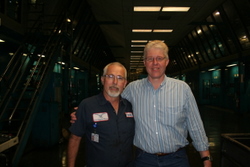 Newspapers have been called the “daily miracle.†The accomplishment of delivering a product of such remarkable breadth and complexity to hundreds of thousands of doorsteps by
Newspapers have been called the “daily miracle.†The accomplishment of delivering a product of such remarkable breadth and complexity to hundreds of thousands of doorsteps by
I never would have met Edward Padgett (left) if it weren’t for this blog. Ed publishes Los Angeles Times Pressmens 20 Year Club. It’s a blog about newspapers, the LA Times, Ed’s longtime buddies in the press room and anything else Edward Padgett wants to write about. Ed’s blog sends more traffic to Newspaper Death Watch than any other site on the Internet, including Google. Ed’s been online for more than 20 years, going back to Prodigy days. He’s very online-savvy.
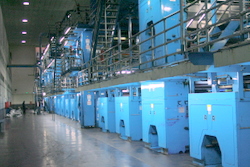
Ed and I have been exchanging links for months, so my trip to LA was an opportunity to get together. For nearly two hours, he showed me around the massive Olympic Blvd. facility of the LA Times. It was a quiet day and the presses were idle. The guys on the early shift were mainly cleaning up, repairing equipment (the Times stopped doing preventive maintenance four years ago) and getting ready for the late-week insanity leading up to the Sunday edition.
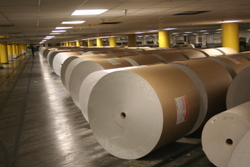
The pressroom is a big place. The presses themselves stand about 20 feet high and stretch for a tenth of a mile. A giant storehouse on the first floor houses hundreds of 2,400-lb. rolls of newsprint, many of which arrive by rail cars that roll right into the warehouse. The newsprint rolls are fed by robotic forklifts to presses as they’re needed. The storeroom shown below doesn’t even hold enough paper for a single day’s edition.
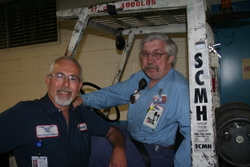
Nearly everyone working the morning shift has known each other for a long time. Ed’s been at the Times for 36 years, but he’s not the most senior guy. John Miner (right) has been there for 37 years. He teaches new hires how to work the presses.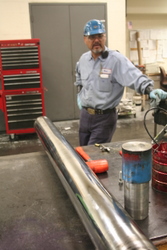
There’s a camaraderie to this crew that only comes from experience. These guys can practically finish each other’s sentences. In this age of outsourcing, we sometimes forget the value of having a workforce that instinctively knows what each other will do in any situation.
The pressmen’s commitment is to the newspaper and to each other. They’ve seen publishers and guys in suits come and go. The guys on the press always outlast the latest manager or the latest management fad. They’ll work their butts off to get the paper out, but they could mostly care less what some executive tells them to do. They’re as friendly with some of the reporters and editors as they are with each other. Ultimately, everyone who works for a newspaper knows that he or she is part of a large and intricate assembly line. The guys in the press room happen to be near the end.
Ed’s blog has an impact. Sam Zell checks it out regularly and even singled out Ed for recognition on a recent visit to the Times. Publisher David Hiller is also a reader. Los Angeles Times Pressmens 20 Year Club is a bit of a thorn in Hiller’s side because Padgett sometimes publishes internal memos or breaks news before it’s meant to be broken. The Times even had the lawyers look into shutting Padgett down at one point, but decided there was nothing they could do. So they enjoy a friendly but somewhat awkward truce. Ed won’t do anything to hurt the paper he loves, but he won’t pull his punches when he sees something wrong. He loves to spotlight LA Times critics like Jim Reich, whose scathing commentaries are a must-read. Hiller has evidently learned to live with it, because he and Ed are on a first-name basis.
Ed gave me a book of Times sports pages and a book of dessert recipes written by a Times staffer as a parting gift. I’m sure we’ll meet again. He is a class act, and so are the other 20-year guys I met, whose pressroom wizardry helps pull off that daily miracle.
More photos below.
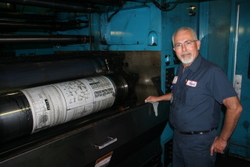
Padgett on press

Newsprint in storage
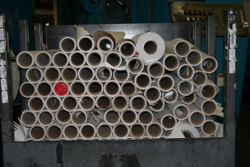
Spent rolls awaiting recycling
Charles Layton of the American Journalism Review is the latest to run the numbers and see little hope for the major metro daily. It turns out that a simple forecast of revenue trends last fall by Recovering Journalist’s Mark Potts was probably too rosy in envisioning a straight annual decline of five percent in print revenues offset by a growth rate of 20% in online revenues. When you extrapolate the recent numbers reported by the Washington Post, you come up with uglier picture.
Revenues decline through 2014 before bottoming out and beginning a slow upward climb. However, by that point the Post is less than two-thirds its current size, and it doesn’t get back to its current size for many years. And the Post, by the way, is better positioned than most newspapers to survive the coming collapse of print advertising. Layton concludes what readers of NDW have long known: many major metro dailies will fail completely. Quoting Potts: “If a big newspaper in a metropolitan area dropped dead right now, nobody under 30 would care.” He stops short of agreeing with our forecast of five survivors in the
Forecast of Mass Media Death Wasn’t Wrong, Only Premature
Slate’s Jack Shafer recalls Michael Crichton’s 1993 forecast of the death of mass media within a decade and says Crichton’s only mistake was timing. “Rot afflicts the newspaper industry, which is shedding staff, circulation, and revenues. It’s gotten so bad in newspaperville that some people want Google to buy the Times and run it as a charity! Evening news viewership continues to evaporate, and while the mass media aren’t going extinct tomorrow, Crichton’s original observations about the media future now ring more true than false.”
In a follow-up interview with Shafer, Crichton confesses that he got a few other details wrong. He expected that customized services would emerge online to satisfy people’s information needs. However, that job seems to have fallen to people’s friends networks instead. “It may be that ‘media’ was never as important as we who work in it imagine it was,” Crichton says. He adds that newspapers and broadcast outlets continue to feed pabulum to readers, who no longer had to consume it. “The biggest change is that contemporary media has shifted from fact to opinion and speculation,” he tells Shafer. And he suggests some ideas for big stories that the media isn’t covering.
Murdoch Sees Plenty of Headroom for WSJ
Rupert Murdoch sees a brighter future for print. “Print will be there for at least 20 years, and outlive me,” he tells The Wall Street Journal‘s Walt Mossberg in an interview at the D conference. Note that he didn’t say “newspapers.” Murdoch does think the Journal will do fine. “New York Times charges $500 a year for subscription…now we charge about $150 a year. We still have a long way to go.” But he adds that the Journal has too much management overhead. “Every piece of story in WSJ has on average about 8.3 editors involved…that is ridiculous. You have to get all of the facts in half the space.” (via Romenesko).
Layoff Log
- The Seattle Times Co. is reportedly laying off workers at its
Maine newspapers. The Newspaper Guild in Portland, Maine, says the Portland newspapers would lay off up to 35 employees. However, the parent company hasn’t confirmed the report. The Seattle Times has been besieged by the weak business climate in its area and has been scrambling to unload itsMaine properties, which are a legacy of the owner Blethen family. - Cablevision Systems Corp. hasn’t yet taken ownership of Newsday from Tribune Co., but heads are rolling nonetheless. Newsday reported on Friday it had laid off 32 employees, half in operations management and half from Star Community Publishing. The paper already cut 120 positions in March.
- The Commercial Appeal newspaper in
Memphis is cutting 55 jobs from its 700-person staff because of slow advertising sales. Cuts will be completed by July 1. The Scripps-owned daily has a circulation of about 150,000.
Search NDW
Subscribe by RSS or E-mail
Pages
Poll
Archives
Our Other Sites
Our Books
Etc.
Of course, we're on...
...and all these other places.
Newspaper Death Watch is licensed under a Creative Commons Attribution 3.0 Unported License.
